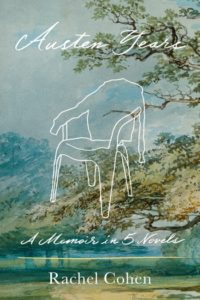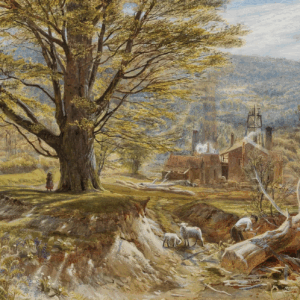
On Jane Austen's Politics of Walking
Rachel Cohen: These Characters Walk to Be Themselves and to Change
Left foot, right foot. Left foot, right foot.
*
Since we last picked our kids up at school, four months ago, we have taken two walks a day around our neighborhood on the south side of Chicago. I think between us my husband and I have walked the six blocks to Gwendolyn Brooks Park in Bronzeville fifty times. Our route is along Greenwood, past the flowering gardens of old brick houses, then across 47th street, past the art café, currently shuttered, near the health clinic and the historic mosque. A block later comes the park, which has a wonderful sculpture of the poet, the only sculpture of a Black woman in a public place in Chicago. On stepping stones behind the statue are lines of Brooks’s poetry that the children love to read and trace with their fingers. Certain lines have gradually become a part of how I move around in the neighborhood, where we live some blocks from the different houses where Gwendolyn Brooks was born, and grew up, studied, taught, wrote, had her own children, and watched the girls and boys as they skipped and ran. A line that feels strikingly resonant now is incised on the first little oblong stone, from Annie Allen, in the voice of a young girl. It reads, “How pinchy is my room!”
Walking to that statue, to read that line on stone underfoot, I feel how these days I am paying different kinds of attention. To the leaves, to losses, to constraints, on bodies and on daily ways.
*
Eight years ago this spring, I began a project that I did not know was a project, of reading Jane Austen nearly every day. I was pregnant, and I thought I was passing the time as I waited for our first child to come. My father was ill, and I thought I was escaping anxiety. Our child was born and my father died. I kept reading Austen. We had another child whom my father did not know about. When the interrupted days began to balance again, I started trying to write about the passage of years of reading Jane Austen, and this work grew into a book, published this week, Austen Years: A Memoir in Five Novels. Through these years, there was one activity that seemed to be a part of writing, and memorializing, of raising children and turning over the news of the world, and even of reading Austen: this was walking.
*
Toward the end of his life, my father had been thinking about walking. He liked to talk with my mother, a theater director, about how actors develop the walks for their characters. He was interested in the ways that tools of mobility—wheelchairs, canes, crutches, cycles and other devices—become extensions that people have characteristic ways of moving with. And he loved the rhythm and gait of poetry. During the two years before he died, he made a project of reading all of William Wordsworth, a poet who composed as he walked.
In Austen walking may be escape, memorialization, independence, recklessness, empathy, self-definition, imagination, leadership.
Most days, my father walked to work—he was a professor studying organization at the University of Michigan—and his colleagues would later remember that they often came up with ideas taking a walk together. His research, into how people form organizations and how those organizations work, reached toward lots of different fields of study: game theory, social psychology, complexity theory, studies of narrative, the history of words, the pragmatists and their ideas of habitual action. I remember a fairly late walk with him where he told me about what people who study perception call “affordances,” the way, when you look at a fence, you know in your body whether the rails would hold your weight and what you would need to do to climb over them. A special awareness flows through a body as it propels itself through the world—the motion, whatever form it takes, is habitual and characteristic for us as we move, but in a way that seems at the same time to make us more able to notice a bug on the sidewalk, the hat of someone approaching. Walking, we draw ourselves and our world together.
*
Every character in Jane Austen has a way of walking. Elizabeth in Pride and Prejudice walks “at a quick pace, jumping over stiles and springing over puddles with impatient activity”; her story resolves on a long walk with Mr. Darcy when they match strides. Marianne Dashwood escapes from oppressive and tedious society to run in the rain, but then the escape makes her ill; at last, she walks with her sister Elinor in a state of relief and mutual understanding. Emma’s father worries so much that he prohibits her from walking beyond their property without a companion; it is partly her confinement that makes her imagination go astray.
In Persuasion, Anne Elliot, who has mourned her mother some thirteen years, grieves to leave the family home, and give up her solitary strolls there, under “the influence so sweet and so sad of the autumnal months in the country.” Her repetitive steps eventually lead her out, into a wider world. It is as she walks by the sea in a coastal town that she begins to wonder if life may hold more for her. Austen’s characters walk to be themselves and to change.
In Austen walking may be escape, memorialization, independence, recklessness, empathy, self-definition, imagination, leadership. The writer knew interiors of “closeness and noise… confinement, bad air, bad smells,” and she knew what it was to go out, to put one foot after another, to be invigorated by “liberty, freshness, fragrance, and verdure” and to think about someone you loved, who was mortal and far away.
*
On our family walks, we see people at six-foot intervals waiting to go into the grocery stores that our corner of the south side has in plenty, but much of the south side does not have. Once a week, I walk to the corner food pantry to drop off a few cans. We have watched the plains grasses filling in everywhere they are let to grow, and the butterflies coming. We have seen three coyotes, though our daughter points out that one was at twilight and we cannot be sure. Another loped across 60th street just before the first time we joined the weekly Black Lives Matter children’s peace march in our neighborhood. In the march, the children walk more slowly than the grown-ups. Their legs are shorter. And they pay attention differently.
*
Jane Austen and her sister Cassandra loved to walk. They walked the green hedgerows around the rectory at Steventon where they grew up, and, after their parents decided to leave this childhood home, the two grown sisters walked on excursions around coastal Lyme and in the small city of Bath where they lived off and on, and in the countryside in Kent, where they stayed with a brother who had become wealthy and owned an estate. They were very close to two other Austen brothers, who had gone to sea, and for a time the sisters shared a household with one of these brothers near Portsmouth and walked the busy streets around the harbor. All these places Austen regularly walked were the landscapes for her books, and knowing them by foot and eye was part of how she imagined her characters into them.
At Chawton Cottage, the house where Jane Austen lived with her mother and her sister from 1809 to 1817, and where she wrote her published novels to completion, their windows faced a fairly busy road. Austen biographer Paula Byrne notes that they were “opposite the inn and close by the village pond.” Austen reported in letters to her nephews on the postchaises and the eight coaches that ran by each day.
Jane Austen and her sister Cassandra were genteel, but without money, and they did not have much space to call their own. The cottage was a belated offer from their wealthiest brother. In the years I spent learning Jane Austen’s novels, I gradually also learned to see that, for the Austen sisters, their own historical moment did not feel to them like the steady upwards progression we are inclined to impose when we study from afar. Instead, they saw a reversal: women in the 18th century had been a vigorous part of the Enlightenment, had been voyaging and writing novels and treading ground that was again off limits to them as, in the early 19th century, England battled the Napoleonic Wars, and consolidated its empire, and as religious conservatism grew.
At the same time, other aspects of life might be opening out and forward. Jane and Cassandra Austen followed with careful attention what their two sailor brothers were reporting to them of the world. Jane Austen believed in abolition, and was proud that her brothers sailed to catch what became illegal slave ships after the Abolition of the Slave Trade Act in 1807. The sisters talked over their world as they walked. They loved the freedom of a discovered prospect, as did the poets they admired, whose lines ran in their heads. Walking itself was changing. In some ways, it was becoming more possible for ordinary people to walk toward change.
*
I have an old and strenuous aversion to the word “domestic.” Writers on the diminished end of whatever spectrum has been set up to disfavor them are often called domestic. Resisting even the hint of this, I had been out of college, working in New York and traveling, for fourteen years before I bought a lamp. In New York, I worked for non-profits that supported new music, queer studies, poetry in public places, racial and economic justice. I shared apartments. When the news first came that my father was ill, my domestic life buckled under the strain of anticipated loss. Domestic life seemed an isolated circle, secluded from, and opposed to, the world. I knew as yet very little of the power of mourning. In mourning, as in walking, the domestic and the world run through one another. Change and mourning are bound up with one another.
In the cities I lived in, and visited, I walked all the time, restlessly, anxiously. I didn’t seem able to slow down. This was how I first read Jane Austen, too, flying through. It took me years of having children, of learning to use broken minutes, to slow down, and read a few words, and learn them until they were a part of the way I walked.
*
“How pinchy is my room!” is from the first poem in Gwendolyn Brooks’s Annie Allen, a poem titled “the birth in a narrow room,” with its opening of such power: “Weeps out of western country something new. / Blurred and stupendous. Wanted and unplanned.” The sculpture of Brooks with the footpath of poetry in the park where we go was conceived of by sculptor Margot McMahon in close collaboration with Brooks’s daughter Nora Brooks Blakely, who thought carefully about how to memorialize her mother in the neighborhood.
Through a window, watching other people walk, the mind ranges.
The line on the first stone of poetry comes from the second stanza of “the birth in a narrow room.” I have thought of its voice as the girl’s, but I realize it could also be the mother’s, or, because Brooks could send a voice in the direction of any other voice, the mother imagining the girl’s.
Now, weeks and years will go before she thinks
“How pinchy is my room! how can I breathe!
I am not anything and I have got
Not anything, or anything to do!”
It is uncanny how when I read this stanza, it seems as if everything that has been happening in the last six months is in the mind of its writer already.
*
The year after we arrived in Chicago, there was a centennial celebration of Gwendolyn Brooks and a conference about her work, one of those gatherings whose depths can suddenly accelerate a person’s education. At one panel, the scholar Jacqueline Goldsby spoke of the windows and interior spaces in Annie Allen and of the relationship through the windows to the streets. Brooks herself often refers to this relationship in describing how she meditated on, and lived with, her material. In the autobiographical Report from Part One:
As for my husband and myself, our own best parties were given at 623 East 63rd Street, our most exciting kitchenette. 623 was right on the corner, the corner of 63rd and Champlain, above a real estate agency. If you wanted a poem, you had only to look out of a window. There was material always, walking or running, fighting or screaming or singing.
Through a window, watching other people walk, the mind ranges.
*
In Wanderlust: A History of Walking, Rebecca Solnit brings out how, in Austen’s England, new kinds of walking came together with other transformations. The growing middle class no longer lived by working the land themselves. Revolutions in the United States and France changed some old rigidities and not others. Public places were becoming safer, more populated and interconnected. Landscape became a place for artistic experience and naturalist observation. J.M.W. Turner was filling his notebooks with landscape watercolors, and John Constable was sketching clouds and treetops as he walked about, spending days in what he called “skying.” Austen’s favorite poet, William Cowper, whose anti-slavery poems were political anthems, wrote of long countryside rambles. Cowper influenced Dorothy and William Wordsworth, who were out walking, too. Austen’s novels seem to refer to Wordsworth’s wonderful walking poem “Lines Composed a Few Miles above Tintern Abbey, On Revisiting the Banks of the Wye during a Tour. July 13, 1798.” For Wordsworth, the metered feet in his poems genuinely were the measure of his stride, a rhythm that freed his imagination. It is a comfort to me that my father had Wordsworth’s language to go walking with.
*
In quarantine, I am reading Maud Martha and Annie Allen again, I am reading In the Mecca with finer attention. Windows and streets are different. In our windows are Black Lives Matter signs. Behind the windows are children, yearning, as ours do, for signs of shared life. In the streets our family is sometimes walking to take the air, and we are also walking, in sweaty masks and six feet apart from other families, carrying our signs in hopes of change. The walks we take, so domestic in their way, map our neighborhood and what is happening in the world.
One of the things about living with a serious writer for a long time is that you learn their language the way you would the gait of someone in your family who you go for a walk with, twice a day. Cadence and rhythm, subtle off-shift of step or word. “I have got / Not anything, or anything to do!” Why is the “not” just there? Because she is serious, there will be answers to the question. And the fact that the language has been considered in this way will help you to keep walking.
*
One of my father’s favorite places to walk was in Gallup Park in Ann Arbor along the Huron River. Whenever I am at home visiting my mother I try to go walk there again. In the winter it can be very cold and snowy along the icy water’s edge; in the summer there are swans, and boats, and children. People stack stones into little tower-sculptures along the paths and these always delighted my father; he liked the way art and nature and playfulness blended in them. Now when I see the stacked stones, I think of the Jewish mourning practice of leaving stones on graves, a way of memorializing with your body and the landscape at once. I think I will put a small stone next to the stones of Brooks’s poems the next time we walk there.
Walking—a way to be yourself that is also a way to pay attention—is a continual integration of experience.
__________________________________

Austen Years: A Memoir in Five Novels by Rachel Cohen is available via Farrar, Straus and Giroux.
Rachel Cohen
Rachel Cohen is the author of three books of nonfiction, most recently Austen Years: A Memoir in Five Novels, which was published by FSG in 2020 to critical acclaim. Her essays have appeared in The New Yorker, The Guardian, The London Review of Books, and The New York Times, among other publications, and her work has been included in Best American Essays and Pushcart Prize anthologies. She is Professor of Practice in the Arts in the Creative Writing Program at the University of Chicago.












